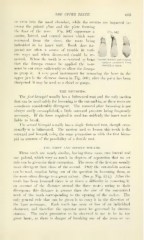Page 605 - My FlipBook
P. 605
THE UPPER TEETH. 603
or even into the nasal ehamber, while the crowns are impacted be-
tween the palatal plate and the plate forming
the floor of the nose. Fig. 542 represents a Fig.
iMG. 542.542.
canine, lateral, and central incisor Avhich were
extracted from the sinus, the roots being
imbedded in its inner Avail. Teeth thus im- '' W \ ^-'^
pacted are often a source of trouble in \avi-
ous ways and when discovered should bo re-
moved. When the tooth is S(^ covered bv bone Canint, latnal, and central
^^"^
that the fl>rceps cannot be applied th^ bone Z^^S^J^^T
must be cut away sufficiently to allow the forceps
to grasp it. A very good instrument for removing the bone in the
upper jaw is the elevator shown in Fig. 500 ; after the point has been
sharpened it may be used as a chisel or gouge.
THE BICUSPIDS.
The first bicuspid usually has a bifurcated root and the only motion
that can be used safely for loosening is the out-and-in, as these roots are
sometimes considerably divergent. The removal after loosening is not
always easily accomplished, a little outward pressure being frequently
necessary. If the force required is used too suddenly the inner root is
liable to break.
The second hicuMpid usually has a single flattened root, though occa-
is bifurcated. The motion used to loosen this tooth is the
sionally it
outward and inward, using the same precaution as with the first bicus-
pid on account of the possibility of a double root.
THE FIRST AND SECOND MOLARS.
These teeth are nearly similar, having three roots, two buccal and
one palatal, which vary so much in degrees of separation that no set
rule can be given for their extraction. The roots of the first are usually
more divergent than those of the second. Only the out-and-in motion
can be used, rotation being out of the question in loosening them, as
the roots often diverge to a great extent. (See p, Fig. 534.) After the
tooth has been loosened there is at times a difficulty in removing it,
on account of the distance around the three roots ; owing to their
divergence this distance is greater than the size of the anatomical
neck of the tooth corresponding to the opening of the socket. The
only general rule that can be given is to carry it in the direction of
the least resistance. Each tooth has more or less of an individual
character, and therefore the operator must be governed by circum-
stances. The main precaution to be observed is not to be in too
great haste, as there is danger of breaking one of the roots or re-


